Selecting specific oils for specific cooking And how best to do it practically
We now understand that oils are our friends if we have insights in their nature as cooking media. Obviously, smart coking with oils must start with using the right oil in every cooking episode. As a refresher, the following conditions must be met concurrently for that:
- The oils should not be altered harmfully during cooking i.e. the cooked food, with oil as a part of it, should be safe as well as tasty (or, at least, free from off-flavors) to eat.
- Since most of our oil consumption is as a part of foods/dishes, our consumption of food (with oil in them) needs to provide the essential PUFA, MUFA and EFA.
- Family’s favorite unrefined oils – ‘double filtered’ groundnut oil is Gujarat’s staple – with familiar flavors must find place.
- All this must happen within quantitative limits overall (i.e. ‘x’ kgs of oils in general/person/day or month or year) and the minutiae of PUFA-MUFA-EFA provision as a fraction of total consumption, within that limit.
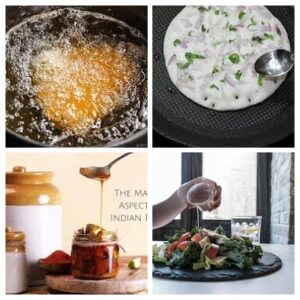
You already know the demands on oils in various modes of cooking and superimposing the characteristics of individual oils on this easily leads to oil selection for each cooking mode. But then cooking modes are many and so are types of oils. Fortunately, the cooking modes can be bunched together and each bunch assigned oils tactfully to arrive at just two oils that will meet all types of requirements of each mode almost perfectly. (In the AI world, this is called ‘optimization’). Surely, stocking just two easily available oils in the kitchen is not cumbersome?! This also simplifies the task of tracking oil consumption quantities by tracking their remaining stocks at various points in time. (Refer the following posts:
- Post 17, Edible oils: an introduction.
- Post 18, Edible oils have many roles outside our body.
- Post 19,The physiological functions of edible oils.
- Post 32, How we cook with edible oils: PartI.
- Post 33, How we cook with edible oils: Part II.
- Post 35, Ideal oils for each cooking mode.)
Since we have already demystified our edible oils as friends and not foes (conditions obviously apply), the acceptance of the need for such nitty gritty and its implementation may sound daunting. Rest assured, it is simple; all it demands from you is some application. The reward is healthy happiness. Nothing worth having can be easy to get. Nothing is so good that it cannot be made better. And successful people don’t do different things, they do them differently.
Conclusion: In practical terms, managing near-perfect oil consumption boils down to: (i) which oils to use for what, (ii) how to select 2 oils smartly that will fulfill all the conditions almost perfectly, (iii) how to track what consumption is actually happening in a month or a year and (iv) how to keep correcting, qualitatively and quantitatively.
We can now dive into types (or quality) of oils for each cooking mode.
THREE STEP PTOTOCOL TO MATCH OILS WITH COOKING MODE
Step I: Listing suitable oils against each cooking mode : This has already been done earlier; here’s a refresher:
-
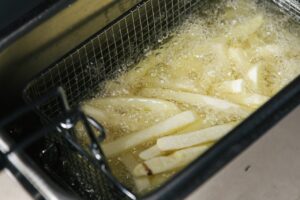 Deep (fat) frying: Unrefined groundnut, mustard, coconut, olive oil. Refined cottonseed, sunflower, corn, rice bran, palmolein oil.
Deep (fat) frying: Unrefined groundnut, mustard, coconut, olive oil. Refined cottonseed, sunflower, corn, rice bran, palmolein oil.  Shallow (fat) frying: Same as above; red refined palm oil can be added given that it will be self-limited by only occasional usage. (Don’t eat tawa- or griddle-fried paratha regularly. Light smearing of ghee on roasted paratha is fine.) We use the best wheat (called ‘daudkhani’ in Gujarat) and find that some shortening is all you need; we don’t even smear ghee on them. Prefer SS, Carbon Steel, ceramic coated utensils. It will be difficult to use highly conductive SAS and copper-bottom vessels (see note below) given the need to modulate heat flux into the pan. Use non-plastic tongs for overturning. Spooning and gently pouring frying oil onto top of load pieces is a good idea. Flame modulation in relation of load (number of pieces in the batch, type and the size) is important; most patty/cutlet compositions have low levels of water, most of which is bound and hence cooking will be slow.
Shallow (fat) frying: Same as above; red refined palm oil can be added given that it will be self-limited by only occasional usage. (Don’t eat tawa- or griddle-fried paratha regularly. Light smearing of ghee on roasted paratha is fine.) We use the best wheat (called ‘daudkhani’ in Gujarat) and find that some shortening is all you need; we don’t even smear ghee on them. Prefer SS, Carbon Steel, ceramic coated utensils. It will be difficult to use highly conductive SAS and copper-bottom vessels (see note below) given the need to modulate heat flux into the pan. Use non-plastic tongs for overturning. Spooning and gently pouring frying oil onto top of load pieces is a good idea. Flame modulation in relation of load (number of pieces in the batch, type and the size) is important; most patty/cutlet compositions have low levels of water, most of which is bound and hence cooking will be slow.
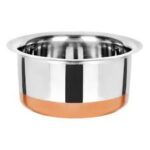 (Note: 1. ‘Copper-bottom’ utensils rightly claim that they absorb flame heat fast and convey it up into the pan. They combine the high thermal conductivity of copper taking flame heat, with corrosion resistance and chemical inertness of SS in contact with food. Its conductivity is intermediate between that of only copper and only SS for the same utensil details. Such utensils are best for evaporative cooking as in ‘reductions’ (chef language) of all kinds. You will usually watch chefs demonstrate on ‘non-stick’ cookware which control the heat input into the dish because of the heat conduction resistance of the deposited Teflon coating. This allows them to talk to you while cooking.
(Note: 1. ‘Copper-bottom’ utensils rightly claim that they absorb flame heat fast and convey it up into the pan. They combine the high thermal conductivity of copper taking flame heat, with corrosion resistance and chemical inertness of SS in contact with food. Its conductivity is intermediate between that of only copper and only SS for the same utensil details. Such utensils are best for evaporative cooking as in ‘reductions’ (chef language) of all kinds. You will usually watch chefs demonstrate on ‘non-stick’ cookware which control the heat input into the dish because of the heat conduction resistance of the deposited Teflon coating. This allows them to talk to you while cooking.
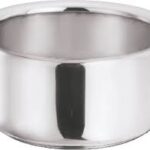 Similarly ‘SAS’ (SS-Aluminium-SS) cooking pans and woks combine corrosion resistance and low reactivity of SS (useful on the flame as well as cooking sides) with better thermal conductivity of sandwiched aluminium. Thumb rule: thermal conductivity-wise, Cu > Al > Carbon Steel (loha or iron) > SS.
Similarly ‘SAS’ (SS-Aluminium-SS) cooking pans and woks combine corrosion resistance and low reactivity of SS (useful on the flame as well as cooking sides) with better thermal conductivity of sandwiched aluminium. Thumb rule: thermal conductivity-wise, Cu > Al > Carbon Steel (loha or iron) > SS.  Only-SS cooking utensils work well, as they allow satisfactory heat flow up the thickness and offer corrosion resistance on both the skins. Intelligent modulation of flame size vis a vis the frying load and smart pan size that does not allow the flame to jut out, are always important. Ref Post No. 10, Cost-benefit analysis of cooking with milk powder.)
Only-SS cooking utensils work well, as they allow satisfactory heat flow up the thickness and offer corrosion resistance on both the skins. Intelligent modulation of flame size vis a vis the frying load and smart pan size that does not allow the flame to jut out, are always important. Ref Post No. 10, Cost-benefit analysis of cooking with milk powder.) -
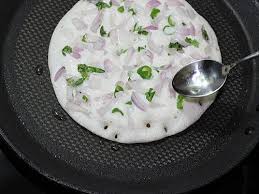 Smear (or film) fat frying: Preferred for high moisture spreadable batters (Chille or pudla or puda, dosa, pancakakes, uttapam, French fried toast – all of which we have been called ‘flats’ earlier) which get some heat absorption buffer from evaporating water. Even then, prefer CS or SS griddles for moderate heat transfer up the griddles, given the short heat path and the quickly increasing temperature of the in-contact side of the dish. It doesn’t help that a lot of water in the batter is ‘bound’ and resists evaporation. Oils: Unrefined groundnut, olive, coconut, ghee or anhydrous milk fat. Refined rice bran, palmolein, cottonseed.
Smear (or film) fat frying: Preferred for high moisture spreadable batters (Chille or pudla or puda, dosa, pancakakes, uttapam, French fried toast – all of which we have been called ‘flats’ earlier) which get some heat absorption buffer from evaporating water. Even then, prefer CS or SS griddles for moderate heat transfer up the griddles, given the short heat path and the quickly increasing temperature of the in-contact side of the dish. It doesn’t help that a lot of water in the batter is ‘bound’ and resists evaporation. Oils: Unrefined groundnut, olive, coconut, ghee or anhydrous milk fat. Refined rice bran, palmolein, cottonseed. -
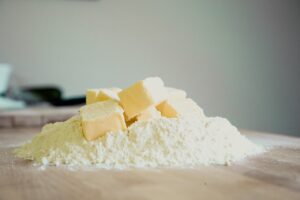 Shortening or ‘moin’: (Ref 1. Post 32: How we use edible oils for cooking, Post 34: Par frying – an interesting industrial mode of frying 2,. Post 35: Ideal oils for each cooking mode.)
Shortening or ‘moin’: (Ref 1. Post 32: How we use edible oils for cooking, Post 34: Par frying – an interesting industrial mode of frying 2,. Post 35: Ideal oils for each cooking mode.)
Oils: Avoid refined soybean oil, high linolenic canola, refined mustard in high temperature baking, especially when the dish is to be stored. Otherwise no restriction. When using ghee or butter in winter, knead with hand to spread the molten fat all around.
- Salad dressing: No restriction other than the flavor of unrefined oils.
- Oil-assisted roasting: As in upama, suji halwa (sheera) and roasted besan sweets. Oils: same as in frying.
- Accompaniment to cooked dishes: E.g. buttered breads, ghee-smeared roti, oiled powder chutneys of South India, oil with Gujarati dhokala and handwo, ghee on ripe mango juice (aamras). No oil restriction.

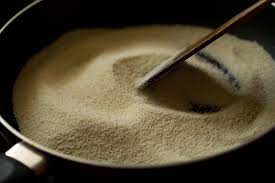

So we now know which oil to reach out for, for which cooking mode, but purely from the oil functionality point of view.
Step 2: Factoring in the refined-unrefined binary: Given the inherent oxidation resistance of unrefined (moderate IV) oils, they would be a ‘shoo-in’ for frying/roasting applications, but, obviously impart their own flavors to the dish. Given the dominance of this mode in Indian cooking, such oils can be the bulk of usage. (Ref Post Nos. 17: Edible oils – an introduction and No. 19: The physiological functions of edible oils.) Obviously, then, the second oil would be a refined oil with complementary attributes. (Post 4: Industrial processed foods, Part I). This pair of oils will cover everything, obviously.
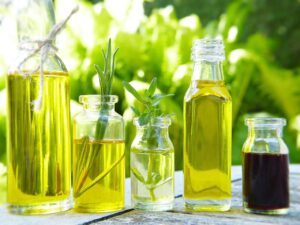
We also know that refining makes oils vulnerable to oxidative spoilage (rancidity) and lean in natural micronutrients. (Ref. post no. 4, Industrial processed foods: Part I and post no. 17, Edible oils: an introduction.) So do refined oils have any positives at all? Yes. 1. They allow the dish flavors to be prominent without any interference. 2. They are available in India at fair prices making refined cottonseed, palmolein, corn and soybean oils attractive.
Step 3: The final, PUFA-MUFA binary: The ‘menu’ from which to select the ‘oil pair’ is quite elaborate and applying the final, essentially nutritional restriction will make the case ‘oil tight’. This restriction stems from the nutritional stipulation that the oils must bring in MUFA and PUFA in a certain proportion so that sustained consumption of the selected pair of oils thru food cooked in them will ensure adequate supply of these categories of fatty acids.
This essentially means selecting from soybean oil, mustard oil and high linolenic canola oil (with corn oil, to some extent) as PUFA sources and the others as MUFA sources – principal among them: cottonseed, palmolein, rice bran, sunflower, olive, coconut and groundnut oils.
So, we have the protocol to select oils covering all quality aspects. Note that we have yet to understand what quantity of oils in general is good for us. The PUFA-MUFA-EFA quantitative requirements are fulfilled by fixing proportions of these fatty acids within the allowable quantity.
INTERCONNECTED MUFA/PUFA & REFINED/UNREFINED BINARIES: Interestingly, EFA-carrying high IV oils (high linolenic canola, soybean, mustard/rapeseed, corn) have to be consumed in refined form for technical reasons and hence they don’t have the preferred protection of natural antioxidants – a double whammy. [Ref post nos. 16 (Oxygen, food and life), 17 (Edible oils; an introduction), 30 (Cancers – the scary scourge) and 34 (Preferred cooking oils for each use.)]. Thus they should be avoided for all versions of frying/roasting, high temperature baking and pickling for year-round storage. Note: Unrefined mustard oil with strong pungency and fair oxidation protection is sometimes used in pickling. We Trivedi’s have stopped doing that because the pickle usually becomes unpalatable by December with barely masked rancidity merging with pungency. The fans of the oil can enjoy its pickles for a few months from May. But avoid the antioxidant-loaded variety. More about it later.
We know that low IV (practically without the essential linolenic acid but with natural anti-oxidants) unrefined oils have inherent oxidation resistance. Hence MUFA and SFA-carrying unrefined oils select themselves for applications for which refined high IV oils are unsuitable. It thus becomes self-evident that we need access to a moderate IV MUFA-SFA oil in unrefined form (pick your regional favorite) and refined PUFA-carrying oil to ‘cover all bases’.
WHAT ABOUT EPA AND DHA-CARRYING PUFA OILS?: Strictly speaking, PUFA should include long chain fatty acids with more than 3 double bonds (principally eicosapentaenoic acid or EPA and docosahexaenoic acid or DHA) because they are PolyUnsaturated Fatty Acids. But they are not a part of our ‘oils for our kitchen for all cooking’ scheme for the following reasons:
- The oils of which they are a part, are so susceptible to oxidation even during storage that they do not stop at becoming rancid; they thicken up due to ‘oxidative polymerization’. They are used in paints as ‘drying oils’ as they help the paint to dry up after application (and contact with atmospheric oxygen) and form a polymeric film on the substrate surface. Obviously, they are unfit for kitchen storage.
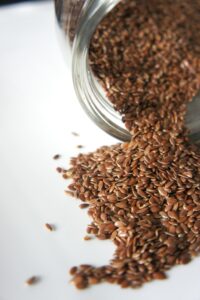 If they are blended with conventional cooking oils at calculated low levels, the oil would still develop rancidity even during simple storage. Obviously, cooking with them should be ruled out. [Flax seed is a good source; reject their ‘roasted’ form available in the market – you don’t know how carefully it was done. Roast it yourself with extreme care (Ref Post No. 16, Oxygen, food and life: Part II, The dark side of oxygen].
If they are blended with conventional cooking oils at calculated low levels, the oil would still develop rancidity even during simple storage. Obviously, cooking with them should be ruled out. [Flax seed is a good source; reject their ‘roasted’ form available in the market – you don’t know how carefully it was done. Roast it yourself with extreme care (Ref Post No. 16, Oxygen, food and life: Part II, The dark side of oxygen].
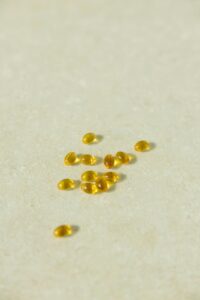 As isolated/extracted oils, they are quite expensive – fish oil is actually marketed as capsules, costing prohibitively on ‘per kg basis’.
As isolated/extracted oils, they are quite expensive – fish oil is actually marketed as capsules, costing prohibitively on ‘per kg basis’.- Our body converts linoleic and linolenic acids – the essential fatty acids – into EPA and DHA. Hence ensuring supply of efa-carrying oils is adequate protection against their deficiency. In fact, the disease conditions originating in even efa deficiency have not been conclusively established. Ensure efa inclusion anyway, why avoid an easily implementable advice?
- EPA and DHA carrying materials are somewhat unusual while linolenic (3 double bonds) and linoleic (2 double bonds) carrying materials are common. Hence ignoring higher PUFA simplifies the narrative (and hence improves compliance) with practically no risk.
Note: 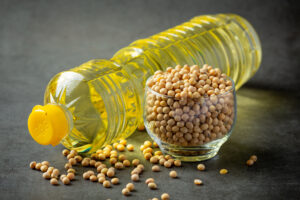 1. Soybean oil (and the bean carrying it) is a very special case in many ways and a separate post is planned later. Do stay in touch to understand why, despite being flawed for frying applications, it deserves a place in your life.
1. Soybean oil (and the bean carrying it) is a very special case in many ways and a separate post is planned later. Do stay in touch to understand why, despite being flawed for frying applications, it deserves a place in your life.
2. We have made quite elaborate arguments in earlier posts about reducing processing of food (wherever possible), the use of artificial or synthetic preservatives in foods and the need for and the possibility of reducing the consumption of such products. In case of cooking oils, synthetic antioxidants (for slowing down oxidation and resulting rancidity) are the only ‘preservatives’. But given the quantities consumed, there is need to raise awareness about their presence in the oils that we trustingly buy. A dedicated post is planned on this pressing topic that has stayed under the radar for far too long.
Next Post:
Ensuring healthy edible oil consumption: Part Ia (Quantity)
Estimating each member’s actual consumption
Visit Disclaimer